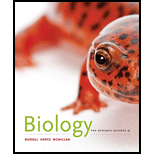
Concept explainers
Introduction:
Food chain is a path through which nutrients and energy move through the ecosystem. Food web is a network of linked/interconnected food chains in an ecosystem. Food web consists of trophic levels based on feeding habits of organisms. Primary producers form the first trophic level of food chain, herbivores form the second level, and carnivores feeding on herbivores are present on the third trophic level. Detritivores and decomposers link all trophic levels.
Answer to Problem 1TYK
Correct answer:
When a robin catches and eats an earthworm, it will transfer the energy and nutrients from detritivores to the higher trophic level.
Explanation of Solution
Justification/explanation for the correct answer:
Option (c) states that when a robin catches and eats an earthworm, it transfers energy and nutrients from the detritivores level to the higher trophic level. This is correct because earthworm is a detritivore that feeds on wastes of other organisms. In the given case, Robin is a carnivorous bird and belongs to a higher trophic level. Thus, when a robin catches and eats an earthworm, energy and nutrients from a detritivore gets transferred to a higher trophic level. Hence, option (c) is correct.
Explanation for the incorrect answers:
Option (a) states that when a beetle eats the leaves of a living plant, it transfers energy and nutrients from the detritivores level to a higher trophic level. This is incorrect because living plants are the producers belonging to the first trophic level. When beetle eats the leaves of a living plant, energy and nutrients gets transferred from first trophic to the second trophic level. So, it is an incorrect option.
Option (b) states that when an earthworm eats dead leaves on the forest floor, it transfers energy and nutrients from the detritivores level to the higher trophic level. This is incorrect because here earthworm is getting energy and nutrients from dead leaves, which are wastes from plants or producers, and not from a detritivore. So, it is an incorrect option.
Option (d) states that when a falcon eats a robin, it transfers energy and nutrients from the detritivores level to a higher trophic level. This is incorrect because falcon is a carnivore that is, it gets energy and nutrients from robin, which is also a carnivore and not a detritivore. So, it is an incorrect option.
Option (e) states that when a bacterium decomposes the feces of an earthworm, it transfers energy and nutrients from the detritivores level to a higher trophic level. This is incorrect because the bacterium belongs to decomposers and is not a part of higher trophic level. So, it is an incorrect option.
Hence, options, (a), (b), (d), and (e) are incorrect.
Thus, it can be concluded that when a robin catches and eats an earthworm, energy and nutrients from a detritivore gets transferred to a higher trophic level. In this case, the earthworm is a detritivore, while the Robin is a carnivore.
Want to see more full solutions like this?
Chapter 54 Solutions
Biology: The Dynamic Science (MindTap Course List)
- Explain how the hormones of the glands listed below travel around the body to target organs and tissues : Pituitary gland Hypothalamus Thyroid Parathyroid Adrenal Pineal Pancreas(islets of langerhans) Gonads (testes and ovaries) Placentaarrow_forwardWhat are the functions of the hormones produced in the glands listed below: Pituitary gland Hypothalamus Thyroid Parathyroid Adrenal Pineal Pancreas(islets of langerhans) Gonads (testes and ovaries) Placentaarrow_forwardDescribe the hormones produced in the glands listed below: Pituitary gland Hypothalamus Thyroid Parathyroid Adrenal Pineal Pancreas(islets of langerhans) Gonads (testes and ovaries) Placentaarrow_forward
- Please help me calculate drug dosage from the following information: Patient weight: 35 pounds, so 15.9 kilograms (got this by dividing 35 pounds by 2.2 kilograms) Drug dose: 0.05mg/kg Drug concentration: 2mg/mLarrow_forwardA 25-year-old woman presents to the emergency department with a 2-day history of fever, chills, severe headache, and confusion. She recently returned from a trip to sub-Saharan Africa, where she did not take malaria prophylaxis. On examination, she is febrile (39.8°C/103.6°F) and hypotensive. Laboratory studies reveal hemoglobin of 8.0 g/dL, platelet count of 50,000/μL, and evidence of hemoglobinuria. A peripheral blood smear shows ring forms and banana-shaped gametocytes. Which of the following Plasmodium species is most likely responsible for her severe symptoms? A. Plasmodium vivax B. Plasmodium ovale C. Plasmodium malariae D. Plasmodium falciparumarrow_forwardStandard Concentration (caffeine) mg/L Absorbance Reading 10 0.322 20 0.697 40 1.535 60 2.520 80 3.100arrow_forward
- please draw in the answers, thank youarrow_forwarda. On this first grid, assume that the DNA and RNA templates are read left to right. DNA DNA mRNA codon tRNA anticodon polypeptide _strand strand C с A T G A U G C A TRP b. Now do this AGAIN assuming that the DNA and RNA templates are read right to left. DNA DNA strand strand C mRNA codon tRNA anticodon polypeptide 0 A T G A U G с A TRParrow_forwardplease answer all question below with the following answer choice, thank you!arrow_forward
 Biology: The Dynamic Science (MindTap Course List)BiologyISBN:9781305389892Author:Peter J. Russell, Paul E. Hertz, Beverly McMillanPublisher:Cengage Learning
Biology: The Dynamic Science (MindTap Course List)BiologyISBN:9781305389892Author:Peter J. Russell, Paul E. Hertz, Beverly McMillanPublisher:Cengage Learning Human Biology (MindTap Course List)BiologyISBN:9781305112100Author:Cecie Starr, Beverly McMillanPublisher:Cengage Learning
Human Biology (MindTap Course List)BiologyISBN:9781305112100Author:Cecie Starr, Beverly McMillanPublisher:Cengage Learning Concepts of BiologyBiologyISBN:9781938168116Author:Samantha Fowler, Rebecca Roush, James WisePublisher:OpenStax College
Concepts of BiologyBiologyISBN:9781938168116Author:Samantha Fowler, Rebecca Roush, James WisePublisher:OpenStax College
 Biology (MindTap Course List)BiologyISBN:9781337392938Author:Eldra Solomon, Charles Martin, Diana W. Martin, Linda R. BergPublisher:Cengage Learning
Biology (MindTap Course List)BiologyISBN:9781337392938Author:Eldra Solomon, Charles Martin, Diana W. Martin, Linda R. BergPublisher:Cengage Learning





